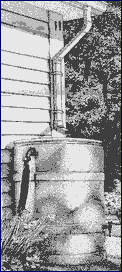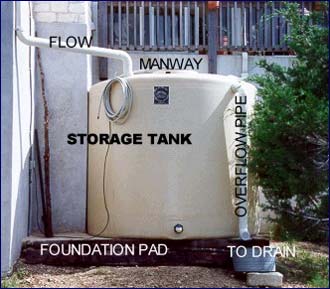A well designed rainwater harvesting system can be an effective way to save water outdoors. While few rainwater systems can completely eliminate the need to use regular treated water outdoors they can be a substantial supplementary supply.
Below are some basic tips for best management of a rainwater harvesting system:
- Maximize catchment by repairing all leaks in gutters and downspouts. Keep gutters clear of all debris.
- Trim tree branches that overhang the roof. Branches are perches for birds and they produce debris.
- If possible, locate your storage tank so that it could be accessed by a water truck – preferably near a driveway or roadway. In the event your water supply is depleted, water could be added from a tanker truck.
- If you plan to store rainwater for any length of time a tight-fitting cover is essential to prevent evaporation, mosquito breeding, and to keep debris and critters from fouling the tank.
- Whenever possible, use gravity rather than a pump as conveyance for your rainwater.
- Frequently monitor your rainwater irrigation system checking for leaks, blocked emitters, and other problems.
It may be an obvious point, but without rain a rainwater harvesting system is of little use. In a severe drought where it simply doesn’t rain for months, a rainwater harvesting system is not much more than a lawn ornament. That’s the bad news. The good news is that during most droughts across North America there is still some rain that occurs.
Furthermore, with sufficient storage capacity, a rainwater harvesting system can be a great asset in mild and moderate drought conditions.
Rain Harvest System Water Savings
Using captured rainwater for irrigation so that regular tap water need not be used is an excellent way to save water. The amount of rainwater captured and available for irrigation is a function of the rainwater harvesting system itself and how much water can be stored.
A single rain barrel holds about 55 gallons of water. If this barrel can be filled and used 20 times over the course of an irrigation season, the savings would amount to 1,100 gallons – assuming 100% of the water can be used to replace standard irrigation.
Savings from rainwater harvesting systems depend primarily on four factors:
- How much rainwater can be captured
- How much rainwater can be stored
- How much rainwater can be used to replace standard irrigation
- The amount of rainfall
Any of these four factors can potentially limit the water savings from a rainwater harvesting system. The amount of rainfall and the amount of storage are often the key limiting factors. Storage is critical because you usually don’t want to use harvested rainwater while it is raining. Ideally the harvested rainwater is stored and then used on days when there is little or no rain.
In Austin, Texas some residential rainwater harvesting systems have storage tanks ranging in size from 1,500 – 2,500 gallons (Gregg, 1999). If you have a collection area of 1000 square feet (quite small) and can collect 80% of the rain that falls it would take approximately 4 inches of rain to fill a 2,000 gallon tank. This is the type of calculation that must be done to determine potential water savings from rainwater harvesting systems.
For detailed information on sizing and designing rainwater harvesting systems download the free pdf here: “Texas Guide to Rainwater Harvesting”.
Rain Harvest System Benefits and Costs
Rainwater harvesting systems range from the simple and inexpensive to the elaborate and costly. If you are considering a rainwater harvesting system it is important to calculate the total amount of water than could be captured, stored, and used in a year with typical rainfall patterns. Using your local water and wastewater rates you can calculate the value of the saved water and determine if the system is cost effective.
 On the simple and inexpensive end of the spectrum are rain barrels. A 57 gallon rain barrel with a cover, overflow hose, and hose bib connection costs about $100.
On the simple and inexpensive end of the spectrum are rain barrels. A 57 gallon rain barrel with a cover, overflow hose, and hose bib connection costs about $100.
If this barrel can be filled and used 20 times during the irrigation season approximately 1,100 gallons of water can be saved. At a value of $3 per 1000 gallons you can see that these devices would not be particularly cost effective, but they can save some water.
A mid-sized rainwater harvesting system may employ a series of rain barrels or a small storage tank. These systems have about 500 gallons of storage capacity and cost $350 – $500. Polyethylene storage tanks are available for between $0.30 and $0.60 per gallon. If a 500 gallon system can be filled and used 20 times during an irrigation season then 10,000 gallons of water can be saved valued at approximately $30 (depending upon local rates).
A larger residential rainwater harvesting system might have storage capacity of 2500 gallons. At a price of $0.50 per gallon, a 2,500 gallon polyethylene storage tank costs $1,250. Total installed cost for the system could be as much as $2,000.
With one inch of rainfall, a 3,000 square foot roof catchment area with 80% efficiency can provide approximately 1,440 gallons of water to the storage tank. In an area that receives 30 inches of rain per year, approximately 43,000 gallons of water could theoretically be captured, stored, and used. The value of the saved water would be approximately $130 (at $3 per 1000 gallons).
Future Trends
Rainwater harvesting has tremendous potential in regions that receive enough rain throughout the year to make systems viable. A relatively small incentive program in Austin, Texas has generated surprising interest in this technology. Advances in drip irrigation will also benefit users and manufacturers of rain harvesting systems.

Not all rain harvesting systems need to have storage tanks and collection systems. Incorporating rain harvesting concepts into landscape design is also an excellent way to take advantage of free water from the sky. For information on integrating rain harvesting into landscape design, click here.
The economics of rainwater harvesting appear to make it a more promising technology for typical residential customers than graywater reuse.
Rainwater systems are relatively inexpensive and as the cost of water increases these systems will become more and more cost effective to purchase and operate. Utility customers have responded enthusiastically to rain barrel give-away programs and to other rainwater harvesting incentive programs. The future of rainwater harvesting may indeed be bright.
- Rain Harvest System Application Options (automatic vs. manual) - January 12, 2017
- Rain Harvest System Timing and Seasonality - January 12, 2017
- Rain Harvest System Installation Tips - January 12, 2017
